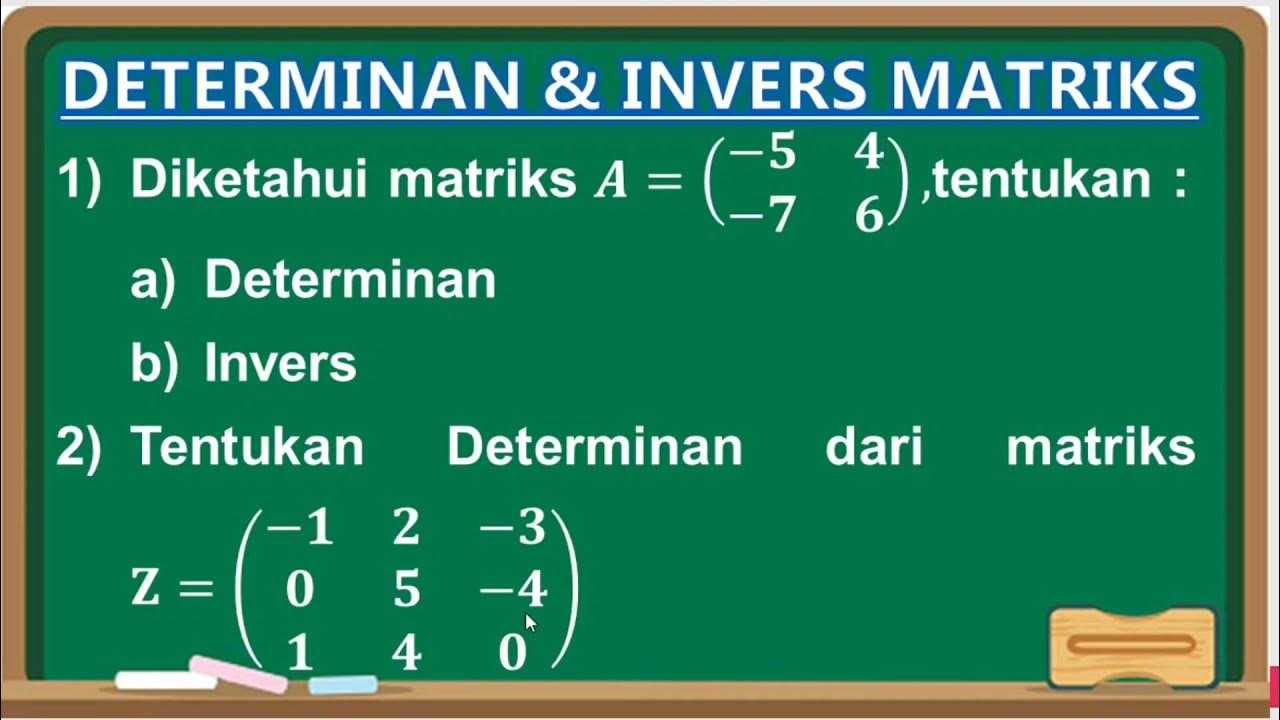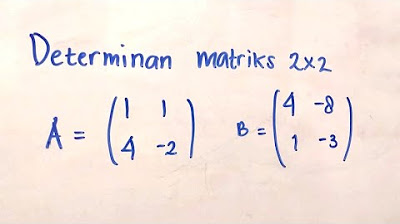Inverse of a 3x3 Matrix
Summary
TLDRIn this video, the process of finding the inverse of a 3x3 matrix is explained step by step. Starting with an augmented matrix that includes both the matrix and the identity matrix, the video demonstrates how to perform elementary row operations to transform the matrix into the identity matrix. These operations are carefully applied to both sides of the augmented matrix, resulting in the inverse on the right-hand side. The final part of the video confirms the inverse's accuracy by multiplying the original matrix by the computed inverse, yielding the identity matrix.
Takeaways
- 😀 The process of finding the inverse of a 3x3 matrix involves transforming the matrix into an augmented matrix with the identity matrix.
- 😀 Elementary row operations are used to manipulate the matrix to make the left side resemble the identity matrix while applying the same operations to the right side.
- 😀 The first step in the row operations is to transform the first row elements and adjust the third row to create zeros in the first column.
- 😀 Row operations such as subtracting and adding multiples of rows are applied to eliminate non-zero entries and achieve the identity matrix.
- 😀 The goal is to manipulate the augmented matrix until the left side becomes the identity matrix, with the resulting right side being the inverse of the original matrix.
- 😀 Operations like multiplying rows by constants (e.g., 2 or 1/2) and adding rows together are key steps in simplifying the matrix.
- 😀 At one point, operations are applied to the second row to eliminate non-zero elements, particularly focusing on making certain entries zero.
- 😀 The process also includes adjusting rows with specific multiples to cancel out terms and simplify the matrix to the identity form.
- 😀 Once the augmented matrix reaches the form where the left side is the identity matrix, the right side contains the inverse of the original matrix.
- 😀 To confirm that the matrix is indeed the inverse, matrix multiplication is performed between the original matrix and its inverse, which should yield the identity matrix.
Q & A
What is the first step in determining the inverse of a 3x3 matrix?
-The first step is to rewrite the matrix as an augmented matrix. This means combining the original matrix with the identity matrix, forming a larger 3x6 matrix.
What role does the identity matrix play in finding the inverse of a matrix?
-The identity matrix serves as the reference matrix. The goal is to manipulate the original matrix through elementary row operations so that it transforms into the identity matrix, while simultaneously applying the same operations to the identity matrix to find the inverse.
What is an example of an elementary row operation used in the process?
-An example of an elementary row operation is adding or subtracting rows to create zeros in specific positions. For instance, subtracting Row 1 from Row 3 to turn a specific element into zero.
What does it mean when a row operation is applied to both the left and right sides of the augmented matrix?
-When a row operation is applied to both the left and right sides of the augmented matrix, it ensures that while manipulating the original matrix to the identity matrix, the same transformations are applied to the identity matrix, which results in the inverse on the right side.
Why is it important to make sure the row operations are applied correctly to both sides?
-It is important because the left side represents the original matrix, and the right side represents the identity matrix. Only by applying the same row operations to both sides will the right side transform into the inverse of the original matrix.
What does it mean to multiply a row by a scalar during the row operations?
-Multiplying a row by a scalar is a type of elementary row operation that scales the entire row by a factor. For example, multiplying Row 1 by 2 and adding it to Row 2 helps create zeros in specific places during the process of row reduction.
What happens if you multiply a row by a scalar like 1/2 or 1/4?
-Multiplying a row by a scalar like 1/2 or 1/4 is used to simplify elements in the matrix, especially when aiming for the identity matrix. For example, multiplying Row 1 by 1/2 and Row 2 by 1/4 helps normalize the matrix.
How do you verify that a matrix is indeed the inverse of another matrix?
-To verify that a matrix is the inverse of another, you multiply the original matrix by the supposed inverse. The result should be the identity matrix, indicating that the two matrices are inverses of each other.
Why do you need to multiply Matrix A by its inverse to check your work?
-Multiplying Matrix A by its inverse is necessary to confirm that the product results in the identity matrix. This step ensures that the inverse was correctly determined during the row reduction process.
What would be the result of multiplying the original matrix by its inverse if done correctly?
-If done correctly, multiplying the original matrix by its inverse will result in the identity matrix, which confirms that the inverse has been accurately calculated.
Outlines

This section is available to paid users only. Please upgrade to access this part.
Upgrade NowMindmap

This section is available to paid users only. Please upgrade to access this part.
Upgrade NowKeywords

This section is available to paid users only. Please upgrade to access this part.
Upgrade NowHighlights

This section is available to paid users only. Please upgrade to access this part.
Upgrade NowTranscripts

This section is available to paid users only. Please upgrade to access this part.
Upgrade NowBrowse More Related Video
5.0 / 5 (0 votes)





